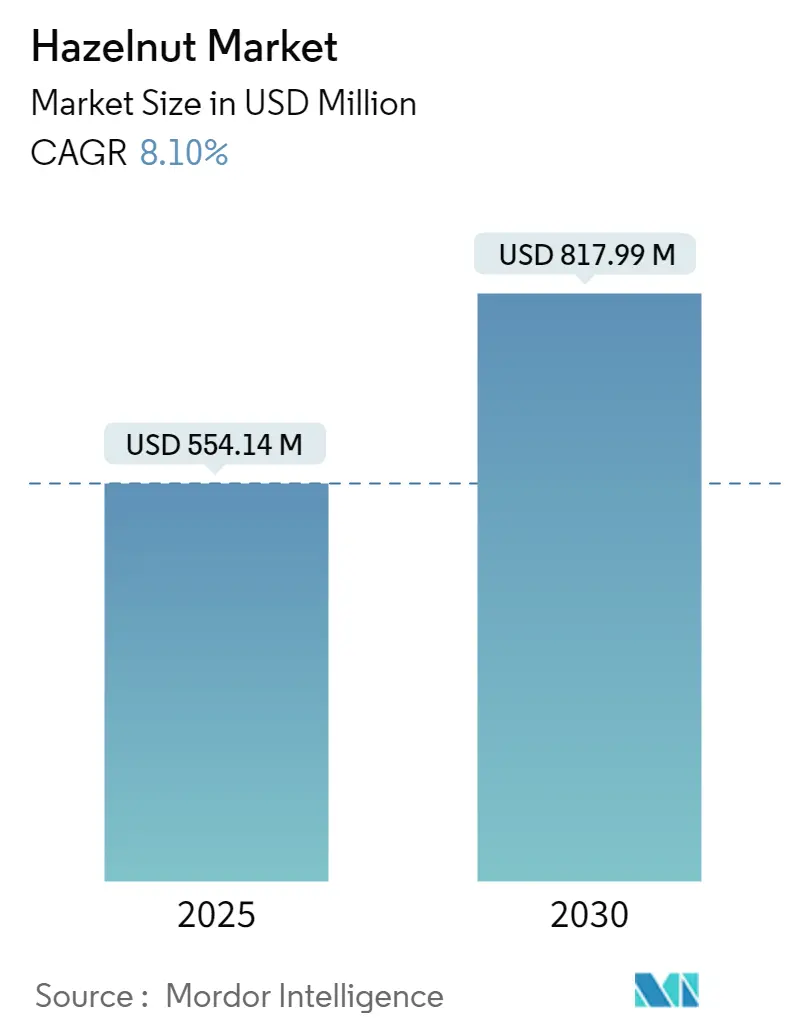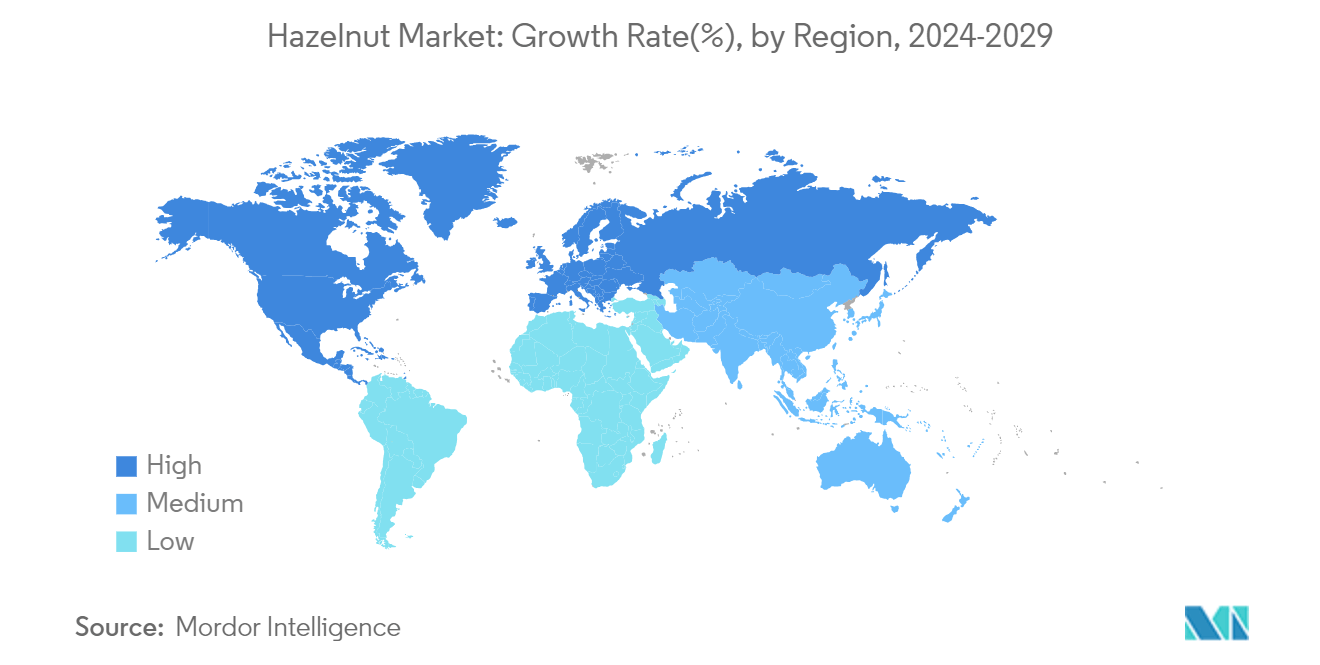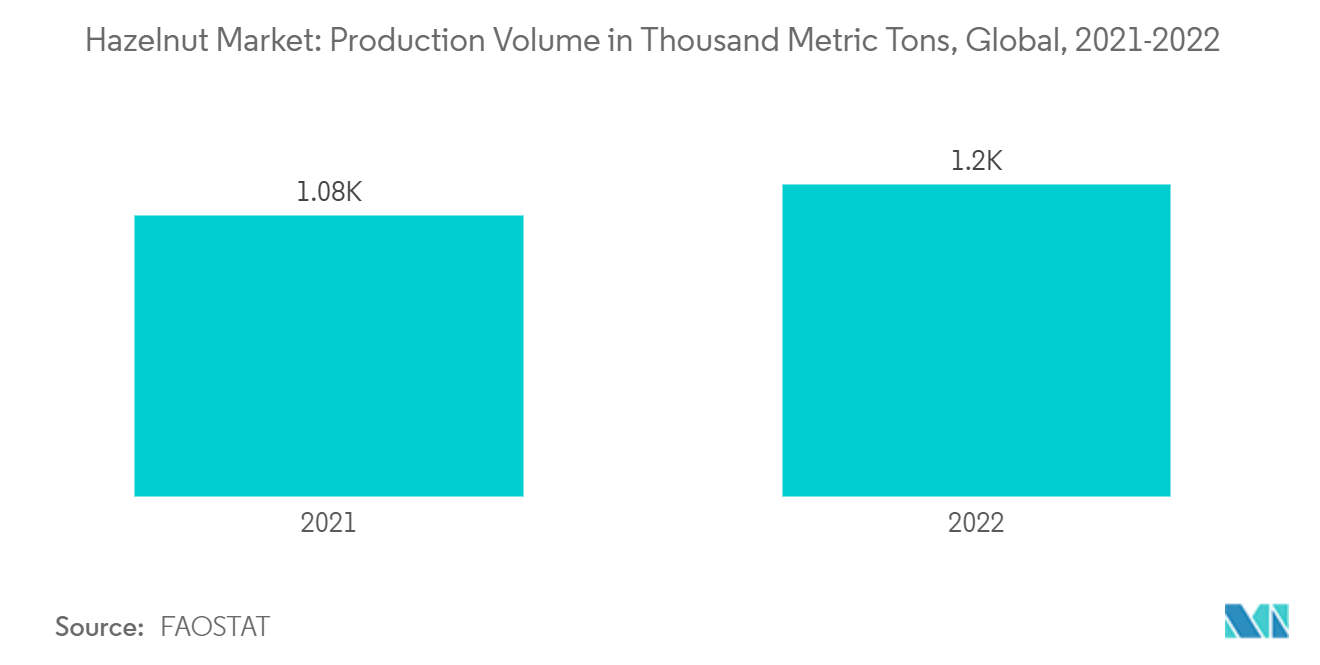
| Study Period | 2019 - 2030 |
| Base Year For Estimation | 2024 |
| Market Size (2025) | USD 554.14 Million |
| Market Size (2030) | USD 817.99 Million |
| CAGR (2025 - 2030) | 8.10 % |
| Fastest Growing Market | Europe |
| Largest Market | Europe |
Hazelnut Market Analysis
The Hazelnut Market size is estimated at USD 554.14 million in 2025, and is expected to reach USD 817.99 million by 2030, at a CAGR of 8.1% during the forecast period (2025-2030).
- Nuts, included in most healthy dietary patterns, are characterized by high energy density due to their high lipid content. Hazelnuts are a rich dietary source of protein, unsaturated fatty acids, and linoleic acid. It contains a higher alpha-tocopherol (vitamin E) concentration than other nuts. The consumption of hazelnuts may also help regulate immunologic and inflammatory responses. Hence, the demand for hazelnuts is anticipated to increase in the future.
- Research shows that consuming hazelnuts can lower LDL (bad) cholesterol and increase HDL (good) cholesterol, increasing sales. Hazelnuts are employed in various sectors, including food, beverage, oil, and cosmetics. They are used in desserts, such as cakes, muffins, chocolate dishes, praline, or pastries. Additionally, as it contains essential skin care elements, it is also used to make a variety of cosmetics, including lotions, soaps, creams, facial oils, and massage oils. The increased application of hazelnuts is expected to increase the demand.
- Along with the increasing demand and increased application for the product, various producers are entering the market with innovative products. For instance, in September 2022, Hershey India, a part of the Hershey Company, a leading global snacking giant and the largest producer of quality chocolates in North America, launched a new variant of Hershey's Kisses called Hazelnut 'n' Cookies under a unique platform, 'Nutty-For-You,' to enable consumers to express their emotions to their loved ones. This type of product innovation caters to the growth of the market.
- Moreover, according to the Food and Agriculture Organization (FAO), the production and export of hazelnuts are high in Turkey. The production volume in Turkey accounted for 665,000 metric tons in 2020, which increased by 765,000 metric tons in 2022, and the provinces of Ordu, Samsun, and Giresun produced the majority of the world's hazelnuts, while Sakarya and Düzce produce them at a high rate.
- In terms of consumption, Europe is likely to register the highest growth due to the increasing demand for hazelnuts from the European chocolate industries. Additionally, as per ITC trade, in 2023, the major import destinations of hazelnuts were Italy, Germany, Spain, and France, with 42.2%, 6.5%, 3.2%, and 1.9% import share, respectively. Therefore, with increasing consumer demand and high health benefits, the market is anticipated to grow during the forecast period.
Hazelnut Market Trends
High Demand from the Chocolate Industry is Expected to Drive the Production
- Hazelnut is the most preferred nut in the chocolate industry. They are used as a side ingredient in chocolate, biscuits, and other confections, accounting for 90% of hazelnut consumption. The increased usage of hazelnuts in chocolates is driving the production of hazelnuts globally. For instance, according to the FAOSTAT, global production of hazelnuts was 1,077.3 thousand metric tons in 2021, which increased to 1,195.7 thousand metric tons in 2022. Chocolate manufacturers are re-introducing their signature products with hazelnut-incorporated product lines, becoming an innovation in taste in the global confectionery market. For instance, in Switzerland, the sales volume of Chocolate confectionery has increased from 31.1 thousand metric tons in 2020 to 34.5 thousand metric tons in 2021, as per the Association of Swiss Chocolate Manufacturers. Further, chocolate hazelnut spreads are gaining popularity, similar to peanut butter.
- Further, many food companies have started making their own versions of this spread, which are available in major grocery chains. For instance, in 2020, the popular hazelnut spread Nutella was a common post-school snack for children, especially in Europe. This spread can be applied over slices of bread. The escalating popularity of Nutella has led to an increased demand for hazelnuts from industries catering to the increasing global consumer demand. Similarly, M&M launched its hazelnut spread chocolate candies featuring a hazelnut spread center covered in delicious milk chocolate.
- Hazelnut adds a fresh flavor to traditional chocolate products and is used to produce ice cream toppings. In Indonesia, the chocolate-hazelnut combination became famous when used in dishes like martabak and toast. These factors boost the sales of chocolates containing hazelnuts in major chocolate-producing countries.
- Hazelnut is a versatile ingredient used in sweet and salty meals, which appeals to millennial consumers who enjoy experimenting with various chocolate flavors. Hazelnuts are a key ingredient at Ferrero and are used in many of its trademark products, including Nutella, Ferrero Rocher, and Kinder Bueno. 25% of the world's supply of hazelnuts goes into making Ferrero products. Chocolatiers are also re-launching their products during festive seasons, with a fusion of traditional and Western styles, generally with luxury nuts incorporated into chocolates, boosting the demand for hazelnuts.
Europe is the Largest Hazelnut-consuming Region
- Nuts play an important role in German cuisine, particularly baked products and confectionery. Hazelnuts and almonds are the most commonly utilized nuts, mainly hazelnuts, as they are less expensive than almonds and other nuts. Most hazelnuts are imported from Turkey to Europe. Hazelnuts have long been a popular food source in Europe.
- According to the International Nut & Dried Fruit Council, Italy holds second place in the world's production and consumption of hazelnuts after Turkey, accounting for 75% of the global production. In Italy, hazelnuts are sold both in-shell and shelled, with in-shell nuts sold as snacks, while shelled nuts are sold mainly to confectioneries and bakeries. An estimated 90% of the hazelnuts produced in the country go to processing companies, while the remaining 10% is for fresh consumption.
- Moreover, 89.7% of the domestic demand within the country is fulfilled through production. The country depends on imports for the rest of the demand. According to the ITC trade map, in 2021, the country imported 12,076 metric tons of hazelnuts valued at USD 36,340 thousand.
- Piemonte is also one of the significant hazelnut-producing areas, accounting for 15% of the total Italian production. Italy typically grows the Corylus avellana variety, which detaches naturally from the husk and falls to the ground, unlike the Turkish type. It is then dried (sun or hot air) and shelled if needed. Tonda di Giffoni in Latium, Tonda Rossa in Campania, Tonda Gentile delle Langhe in Piemonte, and Santa Maria de Jesu in Sicily are some of the significant native cultivars in Italy.

Hazelnut Market News
- June 2023: KP Snacks expanded the Butterkist range with the launch of a new flavor, Crunchy Hazelnut Chocolate, toffee popcorn.
- October 2022: Bevzilla brand launched an exotic and exciting flavor of coffee powder called Turkish Hazelnut on International Coffee Day.
- July 2022: Britannia Good Day, India's largest cookie brand, launched the all-new Good Day Harmony pack, which contains four different types of nuts, including hazelnut, cashew, pistachio, and almond, in every cookie.
Hazelnut Industry Segmentation
Hazelnut is derived from the species of the genus Corylus. Hazelnuts are sold unshelled, as whole, diced, sliced, or ground kernels.
The hazelnut market is segmented by geography (North America, Europe, Asia-Pacific, South America, and Africa). The report covers the production (volume), consumption (volume and value), import (volume and value), export (volume and value), and price trend analysis. The report offers market estimation and forecasts in value (USD) and volume (metric tons).
| Geography (Production Analysis in Volume, Consumption Analysis by Volume and Value, Import Analysis by Value and Volume, Export Analysis by Value and Volume, and Price Trend Analysis) | North America | United States | |
| Canada | |||
| Mexico | |||
| Europe | Germany | ||
| United Kingdom | |||
| France | |||
| Italy | |||
| Austria | |||
| Netherlands | |||
| Spain | |||
| Asia-Pacific | China | ||
| Australia | |||
| India | |||
| Japan | |||
| South America | Brazil | ||
| Argentina | |||
| Middle East and Africa | Turkey | ||
| South Africa | |||
Hazelnut Market Research FAQs
How big is the Hazelnut Market?
The Hazelnut Market size is expected to reach USD 554.14 million in 2025 and grow at a CAGR of 8.10% to reach USD 817.99 million by 2030.
What is the current Hazelnut Market size?
In 2025, the Hazelnut Market size is expected to reach USD 554.14 million.
Which is the fastest growing region in Hazelnut Market?
Europe is estimated to grow at the highest CAGR over the forecast period (2025-2030).
Which region has the biggest share in Hazelnut Market?
In 2025, the Europe accounts for the largest market share in Hazelnut Market.
What years does this Hazelnut Market cover, and what was the market size in 2024?
In 2024, the Hazelnut Market size was estimated at USD 509.25 million. The report covers the Hazelnut Market historical market size for years: 2019, 2020, 2021, 2022, 2023 and 2024. The report also forecasts the Hazelnut Market size for years: 2025, 2026, 2027, 2028, 2029 and 2030.
Our Best Selling Reports
Hazelnut Industry Report
Statistics for the 2025 Hazelnut market share, size and revenue growth rate, created by Mordor Intelligence™ Industry Reports. Hazelnut analysis includes a market forecast outlook for 2025 to 2030 and historical overview. Get a sample of this industry analysis as a free report PDF download.





